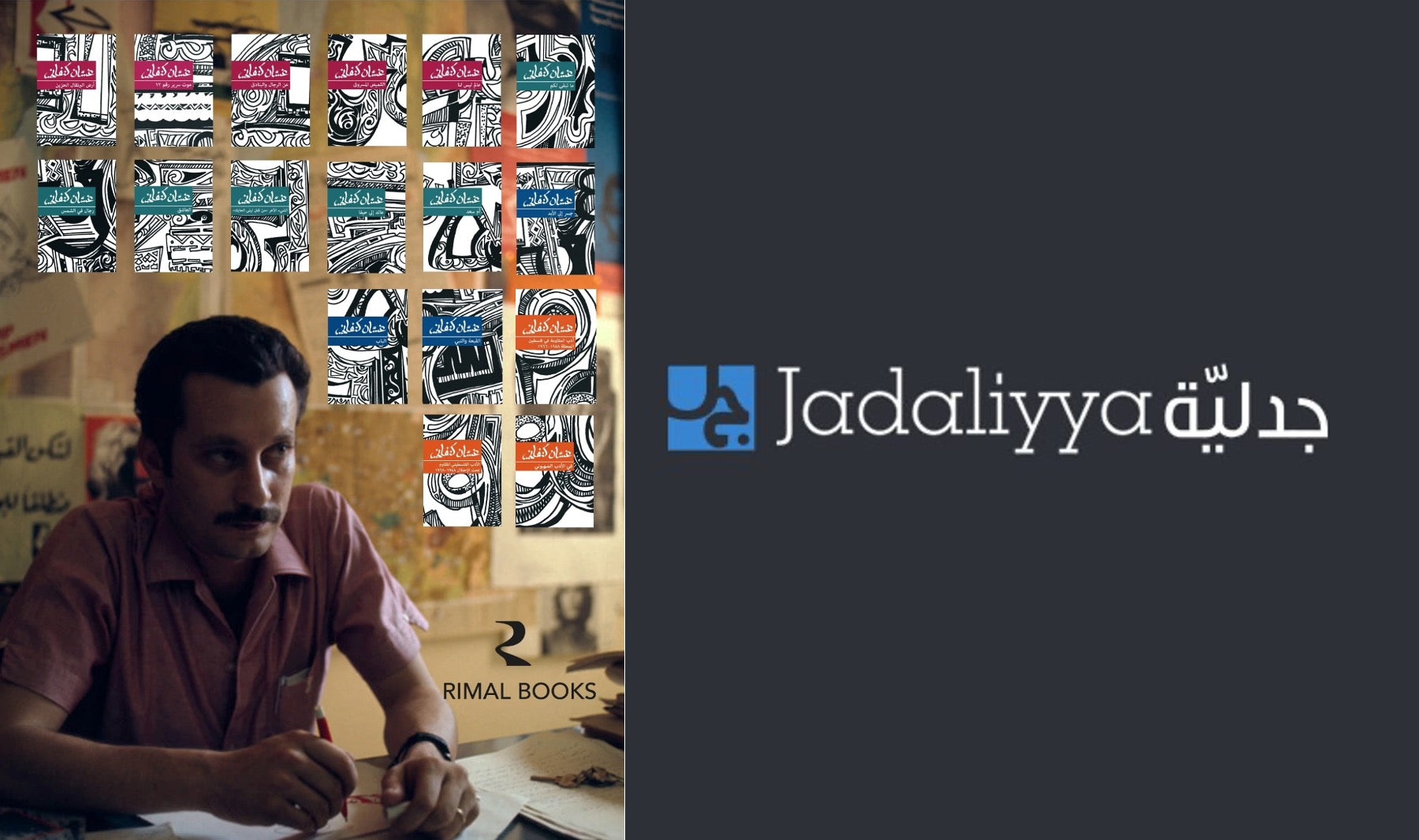
JADALIYYA
As I recall, the year was 1966. We ran to the Nasr Cinema hall in Gaza City to attend a literary seminar held during a conference for the Union of Palestinian Writers. A surprise would unfold whose beauty far surpassed the conference which came together to elect an executive committee and then adjourned.
The conference MC announced that they had invited the young writer Ghassan Kanafani.
A thin, handsome young man went to the podium to speak in a language that combined dream with reality in an ambiance that was more akin to a dream. He told us about "beautiful" poetry that he received from "the other side" which had become mysterious. Our press censors it because it is now part of the entity that was established over our ruins. Ghassan Kanafani told us that day that he would read the poems he "received" from several of the authors of the Galilee: Mahmoud Darwish, Tawfiq Zayyad, Samih al-Qasim, Fawzi al-Asmar, among others. He began reading:
"In our homeland they speak with sorrow
About a friend who departed and returned in a coffin."
I later discovered that this brilliant surprise was part of Kanafani's efforts to present Palestine's Galilee poets to Arab readers through a book that represented the first and most beautiful portal to these poets, who were forgotten and denied from our books, our press, and our consciousness.
I had not read Ghassan's stories until the defeat in the 1967 war. My only knowledge of his literature was through reading his more famous (and in my estimation his most important) novel Men in the Sun. It was presented as a serial by Sawt al-Arab, the most popular radio station in the 1960s. Men in the Sun was published when Ghassan was in his mid-twenties. While it is true that his life was brief, it was also rich in the literature that he offered. A significant landmark of his literary, journalistic, and political journey was his preoccupation with the broader Palestinian national struggle and all of its demands; as was his persistence in penning short texts regularly. Ghassan's friends remember his regular visits to Farouq Cafe in central Damascus. And Fadl al-Naqib recounts how he would frequently write and tear up the pages he wrote, aspiring always for something more beautiful and expressive.
Ghassan Kanafani's tribulations surrounded him on all sides. First, he was a refugee, which was the greatest and most central tragedy. Then he was diagnosed with type 1 diabetes while still a child. Fadl Shururu recalls that Ghassan would inject himself with insulin from time to time and that he fainted during a conference in Cairo for the Arab Journalists' Union in 1966. I will always fondly remember Ghassan's story about his eagerness to hear the opinion of the late Dr. Ihsan Abbas about his story Men in the Sun when the doyen of critics marched rapidly as Ghassan lagged behind to hear his words.
Ghassan wrote the story of the Palestinians who were forced to flee their homelands the year of the nakba, while Emile Habibi wrote the story of those who remained in their country in The Pessoptimist. I once said this in an introduction to an interview I did with Habibi in 1987 for al- Hurriyyah magazine. The late Habibi called me to express his delight with this statement, adding that there was "the third" who elevated the literature of Palestine, referring to Jabra Ibrahim Jabra. Ghassan's journey stretched from Damascus to Kuwait to Beirut as a writer, a journalist, and an editor of al-Huriyyah and Muhallaq Filastin in Lebanon, and later as founding editor of al-Hadaf. He was editor of al-Hadaf until the car explosion outside his home in Dayiat al-Huzaimiyyah near Beirut on the morning of 8 July 1972.
Between literature and politics
Ghassan Kanafani's brief life (1936-1972) combined the production of novels, short stories and journalistic pieces with a commitment to direct political action, which has its infinite concerns that burden creativity and limit free expression. The martyred writer answered to this in an interview on a Scandinavian radio station in his final days. The interviewer asked him if he agreed with those who said that his characters' consciousness surpassed his own. Ghassan responded: "In my political work I defend the organization to which I belong. But in my stories I give my characters the freedom to express their own positions without reservation." Today, when I return to his literary beginnings I can see Ghassan's early consciousness of the interweaving of two important characteristics in his precise and painful representation of the lives of Palestinians after the nakba: the tragedy of the nakba itself as a central calamity, and the miserable fate of Palestinians as individuals and as a community. Perhaps this early realization influenced Ghassan's later political and intellectual views as they reflected themselves in his literature, beginning with his first and most important novel Men in the Sun.
As others did before me, I linger at the delicate and sensitive image that he painted of the Palestinian leadership during the year of the nakba, represented in the character of the truck driver Abul Khaizaran who transports the three other protagonists in the water tank of his truck only to find that they died in the desert heat. This awareness would remain with Ghassan Kanafani, an intellect of middle class background.[1] It was also present with a painful eloquence and a captivating expressiveness in one of the most beautiful chapters of Umm Saad, which he wrote after the defeat of 1967 and the rise of volunteerism among Palestinian youth to join the Palestinian resistance movement. The chapter bears the striking title, "Every tent is not the same" and which I still consider to be one of the most beautiful examples of Palestinian prose. It would radiate thereafter in the work of the poet Mahmoud Darwish, particularly in the eloquent and beautiful book In the Presence of Absence. Ghassan was an avid reader and closely followed the works of emerging writers. He noticed the talent of the writer Mahmoud al-Rimawi, later to become one of the most prominent Palestinian writers, so he gave him control of the culture section of al-Hadaf. He then noticed the poems of Ahmad Dahbour so he wrote a column about him in the newspaper, which Dahbour later used on the cover of his third collection of poetry, The Pilot of Wihdaat. The Iraqi filmmaker Qasem Hawal, who long worked with Ghassan Kanafani in the cinema section of the Popular Front for the Liberation of Palestine's media office said that the writer came to him with a text by Dr. Edward Said, on which he scribbled "read and discuss." Even as he knew that Ghassan was more than just a newspaper editor, that he was a laureate, he was still astonished by this gesture. How was it that he gave the cultural section's employees the responsibility to decide whether or not to publish a text by an intellectual of the stature of Said? Qasem Hawal would discover later that Kanafani's gesture was meant to convey that he respected the authority of the section editors and was dedicated to the institution of journalism.
Educated in the Frere school, Ghassan Kanafani came into life in the diaspora with a fragile grasp on the Arabic language. Because of this, or maybe in spite of it, he toiled to improve his Arabic. He extracted the language's most beautiful expressions and became one of its most captivating writers. He merged human tragedy with a popular folk sensitivity that understands the spirit of the marginalized, and he remained their loyal companion and has not departed for them despite the destruction of his body that bloody morning.
by Rasem Al-Madhoon
__________________________________
[1] His father was a lawyer since the 1920s and sent Ghassan Kanafani to the Frere school in Jaffa .
This article was written in Arabic and published in al-Hayat and Jadaliyya. It was translated into by Nehad Khader.


